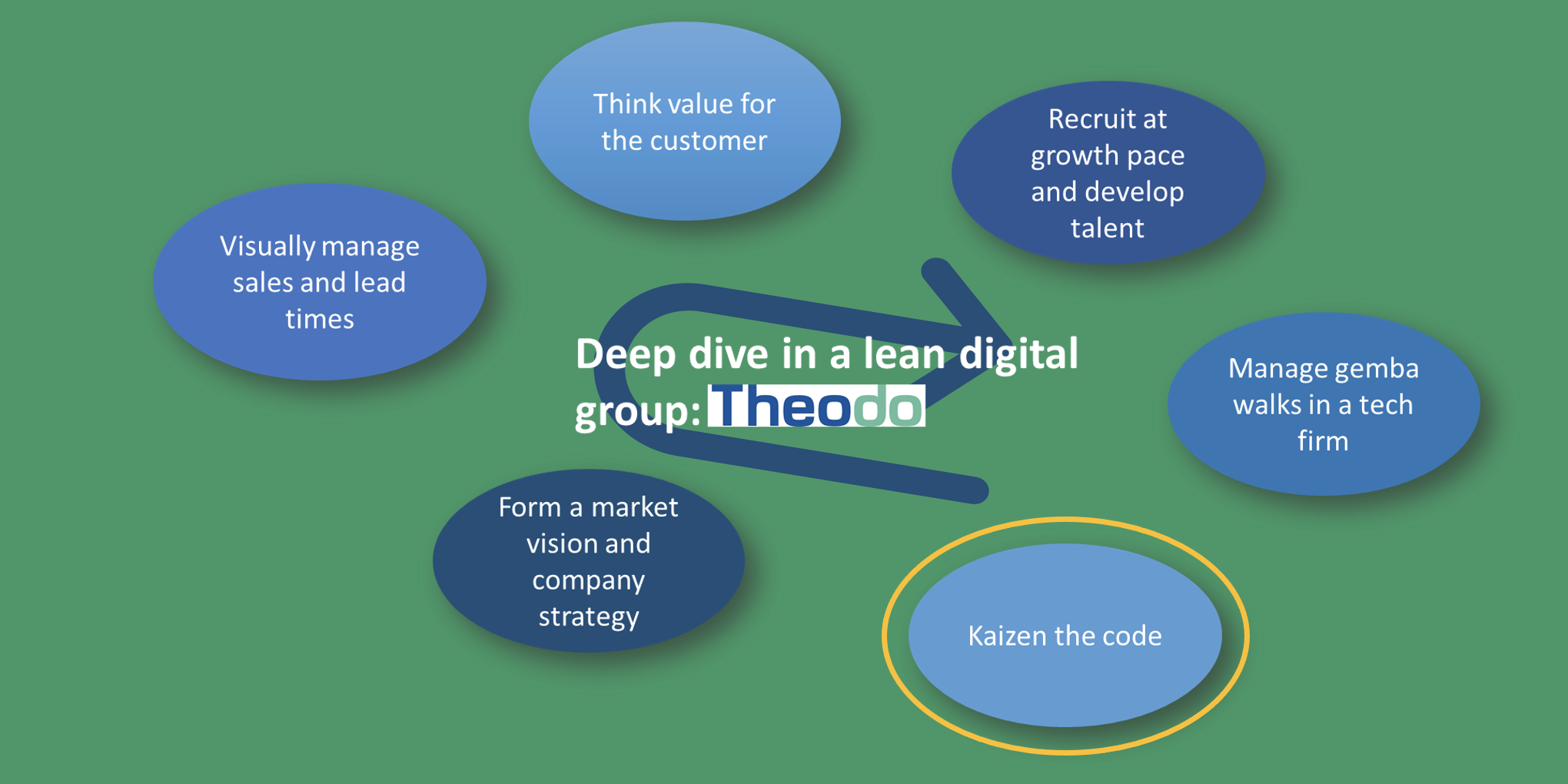
How to create an effective daily management system
FEATURE - With daily management at the heart of its modus operandi, an organization will be able to quickly identify deviation, start solving problems and make strategy deployment a success.
Words: José Roberto Ferro, President, and Robson Gouveia, Project Manager, Lean Institute Brasil
Most organizations try to realize their strategy by simply dropping goals and expectations onto the different areas and levels of the business, giving them sole responsibility for "making the numbers" and monitoring the actions they are expected to carry out.
With this approach, it is no surprise that achievements are often below expectations. Senior managers normally hold a meeting once a month to check on progress (or lack thereof), but this often turns into a finger pointing session rather than an opportunity to discuss disappointing numbers and seek corrective action.
Rushed decisions are then made to fight the fires that seem to pop up everywhere in the organization and to alleviate the situation, which many times makes the situation even worse.
But why are results not achieved? Why is the strategy planning not working? What happens in scenarios like this is that the company's very sophisticated IT system (the repository for all data) doesn't allow for a real grasp of the situation and that decisions are made too late. How can anyone expect to achieve annual target under these circumstances?
Organizations need to implement a new way of monitoring the actions planned and the results achieved, one that ensures an adequate implementation of the strategy and allows for a faster and more effective response to deviation. What organizations need is what we call daily management.
WHAT IS DAILY MANAGEMENT?
Daily management (or DM) is a continuous process that ensures the work is done in the right way and in the right time, in order to achieve business success according to the company's strategic objectives.
It entails the routine monitoring of actions, as defined by the strategy deployment, to verify if the expected results are being achieved and - if they aren't - come up with corrective measures in a timely fashion.
Daily management allows people at all levels of the organization to clearly visualize whether the performance is good or bad on any given day (if necessary, even hourly, weekly or monthly).
It helps to rapidly identify any deviation from target, which makes everybody involved in the process equally responsible for taking the necessary actions to quickly correct the problem and restore the expected level of performance.
The image below shows a management system without daily management, in which a problem affecting performance is not fixed immediately.

Below you can see an illustration of a daily management system – the contrast is pretty stark. Simple visual tools should always make the actual, current performance clear and explain how it compares to the expected performance. This is the only way to effectively highlight deviation.

START BY DEPLOYING STRATEGY TO ALL LEVELS
Daily management starts with a solid process for shaping and then deploying strategy, which has its foundation in the definition and communication of the organization's "True North" – normally a simple and catchy sentence that resembles a mission statement. This explicitly expresses the company's priorities for the near future – let's say about 12 to 18 months.
This "ideal state" is then translated into specific indicators at macro level, which then cascade down to the functional levels (in the form of other, broken-down metrics) until they reach the work cells and ultimately each employee.
Everyone has to be aware of the priorities and challenges of the company and how they relate to their job. That's why it is so important to define the True North in adequate terms: so that people are more likely to be proactive in helping the company to achieve success.
While difficult to realize, the transformation of the indicators defined at the macro level into individual goals for each person and job is a necessary step towards the turnaround of a business. With everyone involved in the decision-making process and given his or her own responsibility, success will be within reach.

The next step is for all areas of the organization (production, administration, commercial, and support functions) to set up charts and visual management boards in extremely visible and accessible places, near the point of work, to ensure the most is made of the meetings that will take place daily (or with any other necessary frequency).
The image below illustrates how the indicators are deployed to each level.

HOW DAILY MANAGEMENT WORKS
To operationalize daily management one must clearly translate the performance metrics defined at strategic level into metrics specific to each department or work cell.
At this point, a team should be formed and a standard for the follow-up meetings established. To fully capture the benefits and the learnings of a daily management system, a new set of leadership attitudes, values and behaviors must also become commonplace.
Last but not least, a "help chain," a structure that supports problem solving across the business, must be put in place.
Aligning everyone's individual job to the strategy
Daily management enables the connection of everyone's specific job with the strategic goals of an organization. Most importantly, it connects the dots between all essential company needs at any point in time. Together, these needs make up your True North.
Everyone should be able to tell how their work is contributing (or not contributing) to the achievement of the company´s objectives as defined by the strategy, at all times. Needless to say, this provides a sense of purpose and belonging among the workforce, as everyone is given the opportunity (often for the first time) to realize how their individual job influences the success of the organization.
Indicators deployment and visual management
Performance indicators defined at strategic level by senior management should be deployed, specified and visually displayed at all levels of the business, using charts like the one shown below. These charts should be filled out according to the updated figures gathered each day.
Visualization must be simple in order to ensure clarity and focus, and to allow everybody to understand. The marks utilized should be as simple as possible: "on target" = green, "off target" = red (to indicate what is going according to plan and what isn't).

How to eliminate chronic problems
Recurring issues are addressed in a special way.
As soon as a chronic problem is identified on the board, a group of five people becomes responsible for addressing it in a structured way, using the scientific method – A3 thinking.
Dedicated kaizen is performed next, to understand the root causes of the problem before any countermeasures are implemented. Then, the A3 and its related issues are monitored in the daily management board for three months. If the problem reoccurs, the A3 is "reopened" to carry out further analysis, formulate new hypotheses as to why the countermeasures didn't work as expected, and to come up with an appropriate response.
The daily meeting and teamwork
For each department, area or cell a team should be put together and asked to get together with regular cadence, even daily if needed, and always at the same time, to discuss the numbers achieved compared the numbers the organization hoped for. Setting a standard for the meetings is critical to their success.
Just having the numbers exposed is not enough: daily management encourages (and, really, calls for) teamwork and cooperation. The team should always engage in frank discussions to understand the situation, do some analysis on the spot, and decide what actions are needed in the event of a gap between current and expected performance.
During the meetings, with everyone facing the daily management chart, it is important to ask the right questions, such as: "Did I do the right thing, in the right quantity and at the right time?" "How are the current results compared to the expected ones?" "What is the problem?" "Why did we deviate from the plan?" "What was the root cause of the deviation?" "What kind of improvements is necessary?" "How can you contribute?" "What kind of help will you need in order to contribute?"
The meeting should be led by the area leaders (the supervisor and his/her leaders in a production area, for instance, or the director and his/her managers in a commercial department).
These get-togethers must be quick (about 30 minutes) and efficient – a standup meeting is normally the best way to keep things short – with everybody focused and concentrated on giving their contribution to solving the problems flagged up by the charts.
The role of leadership: new attitudes and behaviors
Just having the standup meetings is not sufficient. Leadership, which should be heavily involved every step of the way, must be capable of keeping the meetings focused and involving all team members adequately.
They must know what to ask and how to ask it, and be available to help clarify the situation by means of "explanatory questions," until they feel that the group has developed a good understanding of what is going on and is ready to explore the root causes of the identified problem. The role of leadership is critical in that, too: it is by repeatedly asking "Why?" that root causes are unearthed.
During the meeting, no participant should provide an answer that is superficial or given without having carried out a good analysis of the root causes and potential countermeasures to a problem.
Leaders themselves should avoid giving answers or even suggesting them, even when they feel they have a good idea of what could be tried to tackle a specific situation. The reason for this is that standup meetings (if managed properly) are, more than anything else, great opportunities to develop the employees' capabilities and change they way people tackle problems and work in teams.
Discussions should concentrate on the "red dots" - the things that are going wrong - and on the search for effective countermeasures. Rather than looking for someone to blame, people should embrace the idea that it is okay to have problems.
Problems should be exposed and solved
It's necessary to create an environment in which hiding problems is neither acceptable nor possible. The right way to work, which lean thinking advocates for, is exposing problems, effectively solving them, and asking for help and getting it whenever necessary.
Problems occur constantly and the more time is required to understand and solve them, the bigger their consequences.

However, because not all solutions are immediately found or within grasp, it is necessary to create a support mechanism – the so-called "help chain."
The help chain
This is a support system for working cells and workers as they strive to solve problems and add value. It consists of different layers of expertise, skills and management responsibilities, as the figure below shows, which are relied upon to help solve problems the working teams are not capable of solving themselves. Each layer has its own tasks to perform and specific times to respond.

Employees should be able to (or at least try to) solve the problems hindering performance, which should always be solved at the level closest to the process. The support mechanism comes in whenever they can't fix the problem: the team leader is always the first to be called. He/she should work with the workers to try to solve the problem at hand. If they are not capable to do so within a certain time frame, they will involve the group leader, one level up.
This is usually when the process is actually stopped. As counterintuitive as it might sound, interrupting the flow of work is a critical and necessary step when a problem arises (it is the concept of the andon cord). This is the moment the problem is first exposed, and forces the organization to do its best to get to its root cause right away.
If this attempt at fixing the problem fails, too, another level is called upon (it could be supervision, maintenance or quality). Should the issue persist, it is time to call the manager and, if he/she cannot solve it either, the director or even the president (this is of course the case when something really serious happens).
Essentially, the help chain turns the traditional organizational pyramid upside down, which in turns allows the organization to move away from a command-and-control attitude and towards a culture in which all necessary support is given to the processes of value creation and problem solving.
Daily management in a Sales & Marketing department
In this example, we are looking at a Sales & Marketing Department. The board created for the DM carries the following indicators: sales volume per region, percentage of contribution to the overall sales for each region, net margin, orders status, market share, sales leveling, expenses, customer visits, and service. Related to each metric, there is a quantitative target that reflects the expected result, as per the illustration below.
The Sales Director and his managers meet daily to check on the results.

During the Wednesday meeting, they notice a low performance for 11 of the 15 indicators (clearly marked in red). In addition, four problems are revealed to be chronic (pending orders, KLM sales, expenses and customer visits). They require immediate corrective action.
As a result of this situation, the weekly performance will be negative: the results currently achieved are well below the expected levels.
Another problem that emerges during the meeting is the total volume of sales, which proved much bigger than expected as in three regions the volumes were higher than planned.
If small, a higher figure is normal, but a gap much larger than expected is considered abnormal. What would normally be cause for celebration in companies that don't use lean thinking and daily management is, in our example, a reason for concern. The gap might cause instability in the process, hurt the delivery performance, generate unnecessary costs, and may lead to customer dissatisfaction.
In a scenario without DM, this would be just another number that gets lost among the many others that, combined, form the company's portfolio of indicators.
The director and managers, in addition to taking prompt action to correct each number below or above target, come up with a plan to tackle the chronic problems identified:
1. They form a task force composed of the sales management team and the vendors to eliminate pending orders.
2. They put together a promotion (which doesn't compromise margin) to increase sales of the KLM product, which includes banners at points of sales and dedicated help for sales representatives.
3. They define the expenses that can be postponed without compromising sales.
4. They cancel a number of internal meetings to accomodate customer visits.
5. They increase orders for the South, North and Northeast regions to impact sales volume.
Even though market share is also below target, it is just a result indicator that calls for little daily changes and depends, instead, on all other metrics combined. While there is no specific, immediate measure to take, there is an open A3 used to deal with it. In any case, the Sales Director required it to be kept on the board to remind everyone of this objective on a daily basis.
Throughout the department, the reaction to the metrics tends to be slower compared to what normally happens in an environment like a factory floor. If these discussions happened only at the end of the month, the time required to respond and recover would be even higher, with fatal consequences for the year performance.
In the following meetings, the director and the managers are pleased to notice that the actions taken are proving effective, as seen in the next illustration. However, new issues (low sales in the Southeast region and low service levels) emerge on the Friday meeting. They will be dealt with on Monday.
Quick daily meetings (Monday to Friday) reinforce relationships within the commercial team, generating a continuous commitment to achieve the results.
Many organizations choose to do a follow-up, say, once every three days or even twice a month. The company in our example, however, strives to face up to the challenge as quickly as possible and to create the best condition for this to happen at all times. When many people are travelling simultaneously, they often decide to arrange a remote meeting.
In places like department stores or supermarkets, daily management can be necessary on an hourly basis. Quick response to undesired variation will be necessary, and will inpact positively the achievement of daily target, a guarantee of good, sustainable results in the long term.

In many ways, a daily management system brings to the commercial area of an organization a new way of working and stimulates scientific thinking and analysis.
Daily management in manufacturing
In this second example, we look at a manufacturing department.
Senior management has defined the key performance indicators (KPIs) for the whole organization as production volume, financial performance, quality, delivery, people, and health, safety and environment.
The numbers derive from a strategic A3 that covered current business challenges. For each KPI, there is a daily goal that must be achieved if the expected results (in terms of delivering value to customers, ensuring results for shareholders and guaranteeing employees satisfaction) are to be achieved.
There are 16 metrics specific to the production area:
- Production volume
- Deliveries
- Turnover
- Cost
- Delayed quantity
- Defects
- Scrap
- Corrective maintenance
- Number of breakdowns
- Storage days
- WIP
- On-time delivery
- Stock outs
- Overtime
- Absenteeism
- Health, safety and environment.
For each of these metrics, daily targets are deployed, as shown in the board below.
During the daily management meeting that happens on Wednesday a number of problems are highlighted (they are shown in red below), like a low delivery volume, excess expenditures, and in-process inventory, storage interruption and overtime. If nothing is done to correct these anomalies, reaching the expected strategic targets will be extremely hard.

During the meeting, actions needs to be defined and taken in order to attack the root causes of those problems and, if this is not possible as yet, at least try to mitigate them.
At a subsequent meeting, possibly as a result of decisions made, it seems that four of the metrics are still below normal as seen in the next table. They have been throughout the week, which means they require special focus.
As the week progresses, chronic issues seem to be solved, as seen in the figure below, but new problems pop up, such as internal rejection and health & safety cards.

A company is like a living body. If there is no continuous and managed intervention by leadership, problems that are small when they emerge will invariably become bigger.
Will there be days when all metrics are green? Yes, but only as a result of prevention through gemba interaction and daily action taken against root causes.
In this example, we have only discussed two moments in time to illustrate the practices around daily management, but in fact it is an exercise that actually happens every day. The day may suggest it, but people applying it don't always seem to understand that.
TO CONCLUDE
The main purpose of the daily management process is the enabling of robust "Check" and "Act" activities, the lack of which Pascal Dennis described as one of the most critical limitations of strategy deployment in his book Getting the Right Things Done.
An organization that places daily management at the core of its management system will be capable of identifying deviation as soon as it occurs and to initiate the problem solving process right away (if necessary, it will also be able to revisit strategy assumptions and expectations).
Such an organization will be best placed to deal with future challenges, because it has created a solid method for dealing with uncertainty and problems, and because it has continuously engaged and developed its people (the real value creators).
Without daily management, strategy deployment can become an academic exercise, which doesn't drive the proper behaviors and the corrective actions that are necessary to adjust to ever-changing conditions (both internal and external).
Without daily management, chances of failure will be enormous. Unexpected problems will always emerge, and all we can do is ensure that we are best equipped to deal with them swiftly and effectively.
Acknowledgement
The authors would like to thank Tamiris Masetto Manzano for editing and revising this article and to Neio Mustafa for helping with the graphics.
THE AUTHORS

Read more


FEATURE – For a few years now, Theodo has made of quality and customer satisfaction the main focus of its work, and it is paying off. But what does it mean to pursue and improve quality at a digital company?


FEATURE – In this article, you’ll understand how potential errors can become an endless source of personal and managerial growth.


CASE STUDY – Effectively deploying and executing your strategy requires mastering quick follow-ups at different levels of the organization – in other words, Daily Management.


NOTES FROM THE GEMBA – If you need proof that kaizen leads to real innovation, look no further than AIO. This French Tech company that reinvented itself as a karakuri kaizen coach.

